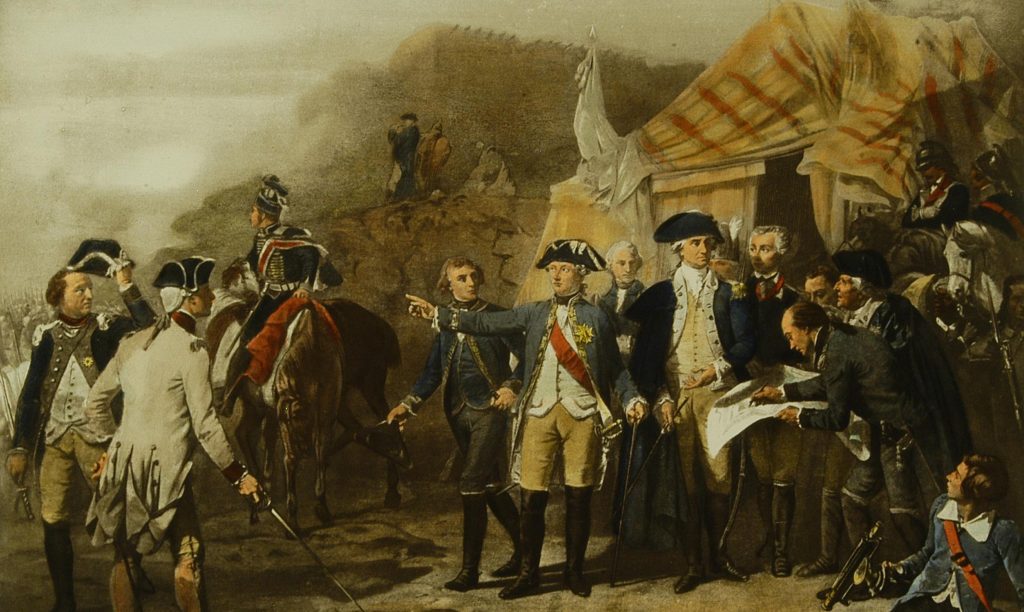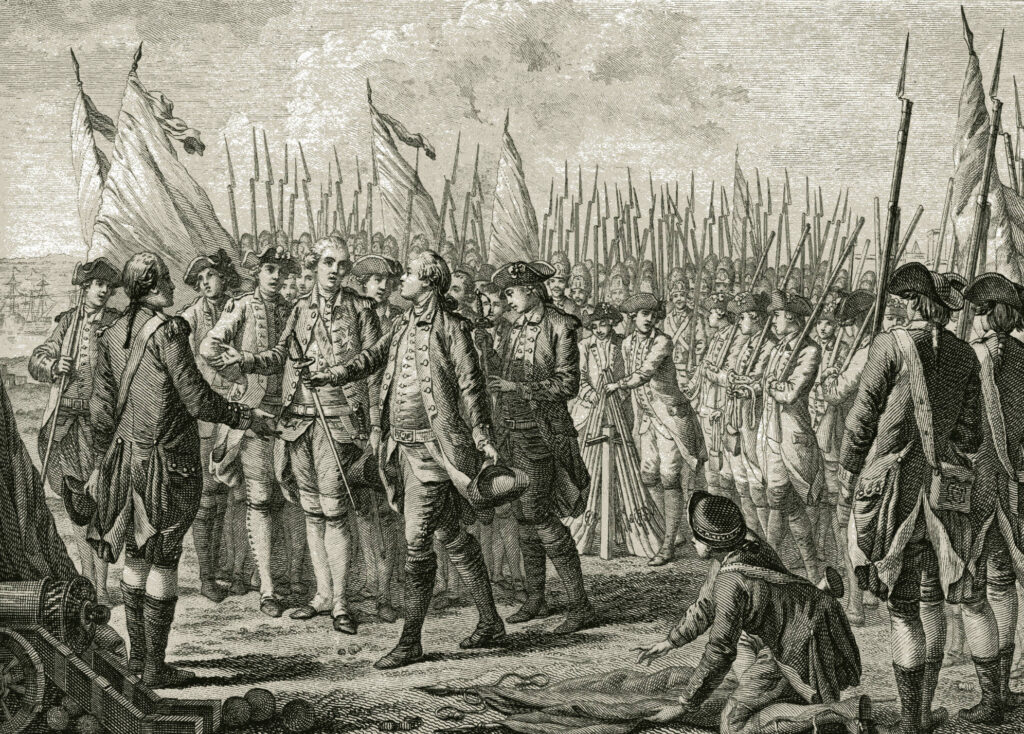Rob Schulte, Reynolds Middle School, Hamilton, New Jersey
DESIGN LEVEL: Middle-High School
The Washington-Rochambeau Revolutionary Route follows the fifteen-month trail of French commander General Jean Baptiste Donatien de
Vimeur, comte de Rochambeau, and his force of more than five thousand French soldiers, from their landing in Newport, Rhode Island, in July 1780 to their rendezvous with George Washington and the Continental Army, and the two armies’ combined march southward to Yorktown, Virginia, where they faced the British in the fall of 1781. These lessons provide a glimpse into late eighteenth-century America through the eyes of the French soldiers and officers engaged along the route, showing a fascinating outside perspective on both life in the colonies as well as the diverse population of soldiers in the American army. The success of the combined Franco-American force at Yorktown ultimately led the British to begin negotiations that would bring the war to a close. Then—and today—the Route is symbolic of the French alliance that secured American independence and shaped the future of global politics.
Objectives
Students will:
- Apply geography skills to track the route of French and American soldiers along the Washington-Rochambeau Revolutionary Route.
- Analyze the writings and drawings of French officers to describe the experiences of Black soldiers in the American Revolution as compared and contrasted with American testimonies documenting the experiences of Black Soldiers along the Route—notably those of Dick Freedom and Cuff Liberty.
- Use cause and effect to demonstrate the impact of the French and American alliance formed along the Washington-Rochambeau Revolutionary Route on the combined victory at Yorktown, using multiple sources including historic maps of the event.
- Describe the legacy of the Washington-Rochambeau Revolutionary Route and the American victory at Yorktown in the creation of the United States and the beginning of a lasting relationship between the two nations.
Materials
Prior to beginning this lesson, students should explore the introductory materials about the Route maintained by the National Park Service (NPS) at: https://www.nps.gov/waro/learn/historyculture/washington-rochambeau-revolutionary-route.htm, and the interactive trail map (showing relevant sites by state) found at the website of the Washington-Rochambeau Revolutionary Route Association (W3R-US) at https://w3r-us.org/.
Introductory Activity:
- Côte de York-town à Boston: Marches de l’armée [“Coast from York-town to Boston: Army marches” map], 1782. Library of Congress. https://www.loc.gov/resource/g3716s.ar074300/?r=-0.094,-0.173,1.111,0.531,0.
- Amérique campagne [“American campaign” manuscript pen-and-ink and watercolor map compendium], 1782. Library of Congress. https://www.loc.gov/resource/g3701sm.gar00001/?st=gallery.
- Chart for the journal of Mr. le Mquis. de Chastellux by Mr. Dezoteux, staff officer in the French Army, 1787. Phillips Academy. https://www.digitalcommonwealth.org/search/commonwealth:j3860877p.
- Now or Never: Yorktown Campaign of 1781, 2014. George Washington’s Mount Vernon. https://www.mountvernon.org/education/videos/films/now-or-never-yorktown.
Activity 2:
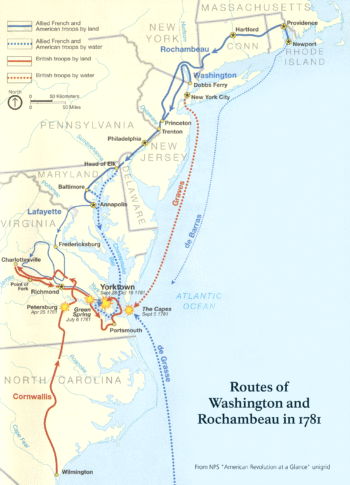
- Soldiers in Uniform from the journal of Jean Baptiste Antoine de Verger (from the Anne S.K. Brown Military Collection at the Brown University Library), ca. 1781-1784. Library of Congress. https://www.loc.gov/item/2021669876.
- Photo Analysis Worksheet. National Archives and Records Administration. https://www.archives.gov/files/education/lessons/worksheets/photo_analysis_worksheet_former.pdf.
- French Accounts of Black Soldiers along the Washington-Rochambeau Revolutionary Route, compiled by R. Schulte for ARI. https://www.americanrevolutioninstitute.org/wp-content/uploads/2024/10/French-Accounts-of-Black-Soldiers-along-the-Washington-Rochambeau-Revolutionary-Route-compiled-by-R.-Schulte-for-ARI.pdf.
- Verger’s Four Soldiers: Diversity in the Colonial Army webpage. The American Revolution Institute. https://www.americanrevolutioninstitute.org/four-soldiers-diversity-in-the-continental-army/.
- French Accounts and Four Soldiers Analysis Questions, compiled by R. Schulte for ARI. https://www.americanrevolutioninstitute.org/wp-content/uploads/2024/10/French-Accounts-and-Four-Soldiers-Analysis-Questions-compiled-by-R.-Schulte-for-ARI.pdf.
- Partially printed D.S., Hartford, June 7th 1782: receipt of Pay-Table-Committee. The Robert Charles Lawrence Fergusson Collection of the the Society of the Cincinnati (see gallery below).https://cdm16923.contentdm.oclc.org/digital/collection/p16923coll3/id/1721.
- “In League with Liberty: The Persistence of Patriots of Color and the Formation of the First Rhode Island Regiment of the Continental Army” featuring Robert Geake. February 16, 2023. The American Revolution Institute (see gallery below). https://www.americanrevolutioninstitute.org/video/in-league-with-liberty-the-persistence-of-patriots-of-color-and-the-formation-of-the-first-rhode-island-regiment-of-the-continental-army/.
- African American Soldiers webpage. The American Revolution Institute. https://www.americanrevolutioninstitute.org/african-american-soldier/.
Activity 3:
- Plan of the investment of York and Gloucester, by Sebastian Bauman, Philadelphia: 1782. The Robert Charles Lawrence Fergusson Collection of the the Society of the Cincinnati (see gallery below). https://cdm16923.contentdm.oclc.org/digital/collection/p16923coll1/id/22/rec/1.
- Yorktown Map Analysis and Summary Translation, compiled by R. Schulte for ARI. https://www.americanrevolutioninstitute.org/wp-content/uploads/2024/10/Yorktown-Map-Analysis-and-Summary-Translation-compiled-by-R.-Schulte-for-ARI-.pdf.
- Now or Never: Yorktown Campaign of 1781, 2014. George Washington’s Mount Vernon. https://www.mountvernon.org/education/videos/films/now-or-never-yorktown.
- Map: Battle of Yorktown, French webpage. George Washington’s Mount Vernon. https://www.mountvernon.org/education/primary-source-collections/primary-source-collections/article/map-battle-of-yorktown-french.
- “Reddition de l’armée du Lord Cornwallis,” dessiné par le Barbier peintre du Roi ; grave par Godefroy de l’Academie Imp.le et Royale de Vienne & c, a Paris [“Surrender of Lord Cornwallis’ army,” drawn by the King’s Painter Barbier, engraved by Godefroy of the Imperial and Royal Academy of Vienna & c, in Paris]. The Robert Charles Lawrence Fergusson Collection of the the Society of the Cincinnati (see gallery below). https://cdm16923.contentdm.oclc.org/digital/collection/p16923coll5/id/54.
- “Surrender of Lord Cornwallis” by John Trumbull, 1819-1820. The Architect of the Capitol. https://www.aoc.gov/explore-capitol-campus/art/surrender-lord-cornwallis.
Activity 4:
- Social Media Exit Ticket, compiled by R. Schulte for ARI. https://www.americanrevolutioninstitute.org/wp-content/uploads/2024/10/Social-Media-Exit-Ticket-compiled-by-R.-Schulte-for-ARI-.pdf.
Recommended Time
Two 90-minute or three 60-minute class blocks. Estimated lesson time below relative to each activity.
Lesson Activities
INTRODUCTORY ACTIVITY (30 minutes): Mapping the Washington-Rochambeau Revolutionary Route
Share the “Coast from York-town to Boston: Army marches,” “American campaign,” and Chart for the journal of Mr. le Mquis. de Chastellux… maps with students to explore the path of the Route.
1. Project the “Coast from York-town to Boston: Army marches” map to the class. Using information provided in the NPS and the W3R-US background materials, trace the route along the map, and discuss the following:
Q: Where do the French land in America? Why is this landing important?
A: Newport, RI. The French have landed ground forces on American soil for the first time in the conflict.
Q: Where did Rochambeau and the French army meet with Washington?
A: Hartford, CT.
2. After showing a relevant selection from Now or Never: Yorktown Campaign of 1781, and further consulting the background introductory materials, ask students:
Q: What were the two potential targets identified by the joint French and American forces?
A. New York, NY and Yorktown, VA.
3. Using all maps, ask students:
Q: What is the final destination Washington and Rochambeau decide on?
A: Yorktown, VA.
4. Compare the historic map projected to the map provided by the National Park Service by asking students to identify locations from the historic map on the modern brochure.
5. Ask students to use the background introductory materials to:
a) identify the challenges the combined Franco-American force would face as it traveled the substantial distance to Yorktown, and
b) determine how they overcame such obstacles.
challenge 1: a) supplies needed for the large force, b) overcome by purchasing agents and foraging supported by a massive wagon train to transport goods
challenge 2: a) inadequate roads and pathways, b) overcome by assigning men to fill potholes and clear obstacles
challenge 3: a) weather/heat, b) overcome by avoiding marches in the heat of the day—regiments got up early with reveille around 2:00 a.m., and by 4:00 a.m. at the latest, regiments were on their way
ACTIVITY 2 (40-60 minutes): Black Soldiers along the Washington-Rochambeau Revolutionary Route
1. Ask students to use the Photo Analysis Worksheet from the National Archives and Records Administration to examine Verger’s “Soldiers in Uniform from the journal of Jean Baptiste Antoine de Verger,” a.k.a. “Four Soldiers.”
2. Have students read selections from the journals of French officers in the PDF titled French Accounts of Black Soldiers along the Washington-Rochambeau Revolutionary Route, compiled by R. Schulte for ARI, and the analysis of “Soldiers in Uniform from the journal of Jean Baptiste Antoine de Verger,” a.k.a. the “Four Soldiers” and Diversity in the Continental Army, at the ARI webpage titled Verger’s Four Soldiers: Diversity in the Colonial Army.
3. Ask students to complete the chart and questions in the PDF titled French Accounts and Four Soldiers Analysis Questions.
4. Project the image of the Partially printed D.S., Hartford, June 7th 1782: receipt of Pay-Table-Committee “to secure the payment of thirty two pounds ten shillings & two pence it being the balance due to Dick Freedom, on the the first day of January 1780, as stated by the committees of the state and of the army…”
Explain to students that this is a receipt demonstrating that the soldier Dick Freedom was paid for his service in the all-Black Second Company of the Fourth Connecticut Regiment of the Continental Army that traversed the Washington-Rochambeau Route. A fellow soldier, Cuff Liberty, signed on behalf of Dick Freedom. Freedom, from the town of Wallingford, CT, served from 1778-83, and Liberty, from Middletown, CT, served from 1777-83.
Ask students:
Q: What do this document, and our readings, tell us about the service of these men?
A: They served in the army and received payment for that service.
Q: What can you learn by looking at their names?
A: Black soldiers adopted aspirational names during their service to reflect the high ideals of the American Revolution and their own personal freedom and liberty.
EXTENSION ACTIVITIES:
- Students may view a video from The American Revolution Institute on the Rhode Island Regiment entitled “In League with Liberty: The Persistence of Patriots of Color and the Formation of the First Rhode Island Regiment of the Continental Army.”
- Students may read about a “Watercolor sketch representing Private Cato Varnum of Captain Stephen Olney’s Light Infantry Company, Rhode Island Regiment, 1781 by Peter F. Copeland, based on research by Marko Zlatich” at the ARI webpage titled African American Soldiers.
ACTIVITY 3 (60 minutes): Activity: Comparing French and American Perspectives on the Victory at Yorktown
1. Give students a copy of the Sebastian Bauman map “…plan of the investment of York and Gloucester.”
2. Ask students to complete the map activity in the PDF titled Yorktown Map Analysis and Summary Translation (which also refers back to the Now or Never: Yorktown Campaign of 1781 video.
EXTENSION ACTIVITY:
1. Invite students to compare the American perspective of the Battle of Yorktown (depicted by the Bauman map), with the French perspective of the Battle depicted in the interactive map on the webpage titled Map: Battle of Yorktown, French, maintained by George Washington’s Mount Vernon.
2. Ask students to compare and contrast the French engraving “Reddition de l’armée du Lord Cornwallis [Surrender of Lord Cornwallis’ army]” and the American painting “Surrender of Lord Cornwallis”—two images of the same event. Students should list 5-10 specific details addressing the differences and similarities of the two images, and be prepared to discuss them as a class.
3. Show (or re-show) students the relevant section of the Now or Never: Yorktown Campaign of 1781 video.
4. Conduct a classroom discussion using the following:
Q: Who are the key figures we have learned about in these lessons that we can identify in each image? What are they doing? What is the event taking place in each image?
Q: Who created each of these images? What are the artists’ perspective and how does perspective impact the way each artist depicts this event?
Q: How does the video summarize the same event? Is either image an accurate portrayal of the event? Which image is more accurate and why?
A: The French engraving is more contemporary and incorporates the British attempt to surrender to Rochambeau.
Q: How do these images reflect the contributions of both France and America to this battle and to the larger war?
Q: What is the significance of the Battle of Yorktown? How is that significance reflected in these images?
ACTIVITY 4 (30-50 minutes): Activity: The Washington-Rochambeau Legacy
Instruct students to read the brief selections of letters between Washington and Rochambeau after the war (contained in the PDF titled Social Media Exit Ticket). Ask students consider the enduring legacy of friendship between the two men and the two nations by summarizing what they have learned in a social media exchange of 280 characters or less.
FINAL ASSESSMENT:
Students will design historical markers and monuments for the Washington-Rochambeau Revolutionary Route with a specific focus on one of the topics and resources presented in the lesson.
Standards Addressed
2020 NEW JERSEY STUDENT LEARNING STANDARDS FOR SOCIAL STUDIES
6.1.12.HistoryUP.2.a: Using primary sources, describe the perspectives of African Americans, Native Americans, and women during the American Revolution and assess the contributions of each group on the outcome of the war.
6.1.8.CivicsDP.3.a: Use primary and secondary sources to assess whether or not the ideals found in the Declaration of Independence were fulfilled for women, African Americans, and Native Americans during this time period.
6.1.8.HistoryUP.3.b: Examine the roles and perspectives of various socioeconomic groups (e.g., rural farmers, urban craftsmen, northern merchants, and southern planters), African Americans, Native Americans, and women during the American Revolution, and determine how these groups were impacted by the war.
6.1.8.HistorySE.3.b: Analyze a variety of sources to make evidence-based inferences about how prominent individuals and other nations contributed to the causes, execution, and outcomes of the American Revolution.
6.1.8.GeoSV.3.a: Use maps and other geographic tools to construct an argument on the impact of geography on the developments and outcomes of the American Revolution including New Jersey’s pivotal role.
6.1.8.HistoryUP.3.c: Analyze how the terms of the Treaty of Paris affected United States relations with Native Americans and with European powers that had territories in North America from multiple perspectives.
NJSLSA.R8.: Delineate and evaluate the argument and specific claims in a text, including the validity of the reasoning as well as the relevance and sufficiency of the evidence.
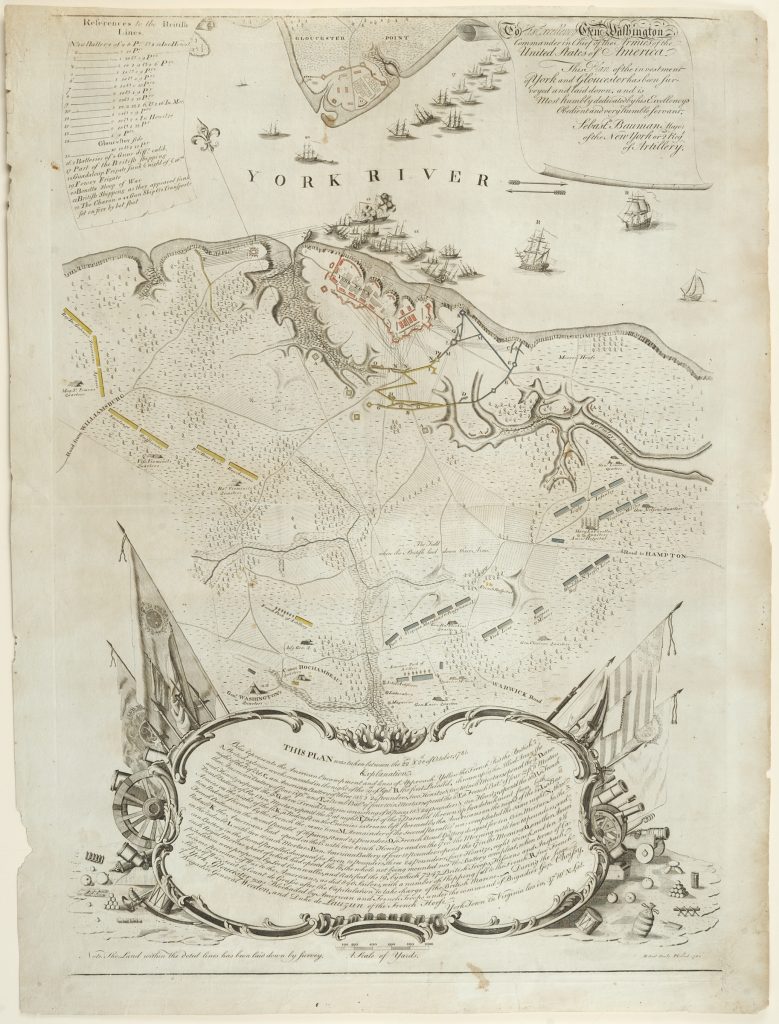
Plan of the Investment of York and Gloucester
Sebastian Bauman
Philadelphia, 1782The Robert Charles Lawrence Fergusson Collection
Within days of the British surrender at Yorktown, General George Washington directed Major Sebastian Bauman of the Second Regiment Continental Artillery to survey the battlefield and encampments. The following year Bauman collaborated with a Philadelphia engraver, Robert Scot, to publish this elegant large-scale map “in order that the public may form an idea of that memorable siege.” Dedicated to General Washington, Bauman’s plan provides remarkable detail of the topography, fortifications, siege works, positions of the American and British lines, headquarters of the commanding officers and “The Field where the British laid down their Arms.”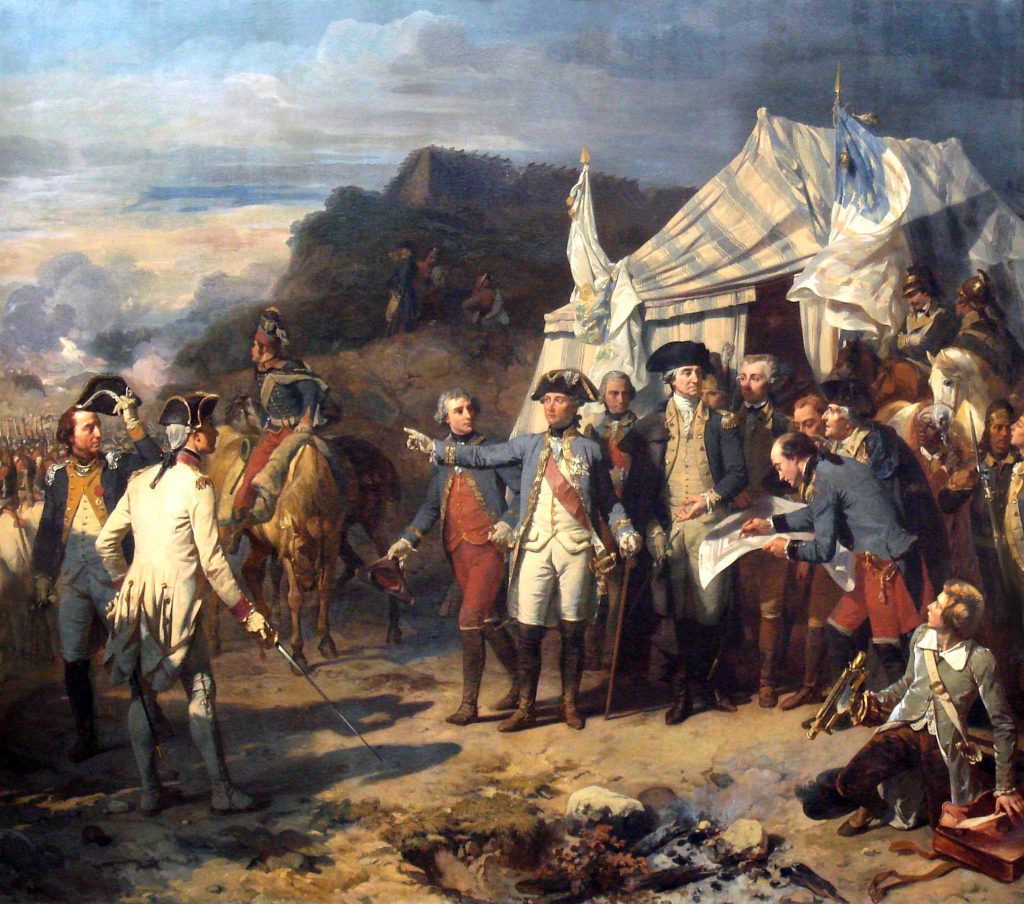
Washington et Rochambeau donnant les derniers ordres pour l'attaque d' Yorck-Town
Louis-Charles-Auguste Couder, artist, Felix Massard, engraver
Paris? ca. 1840The Society of the Cincinnati
Engraving of Rochambeau, Washington and Lafayette standing outside a tent on the battlefield at Yorktown with their officers, reviewing the plans for the battle.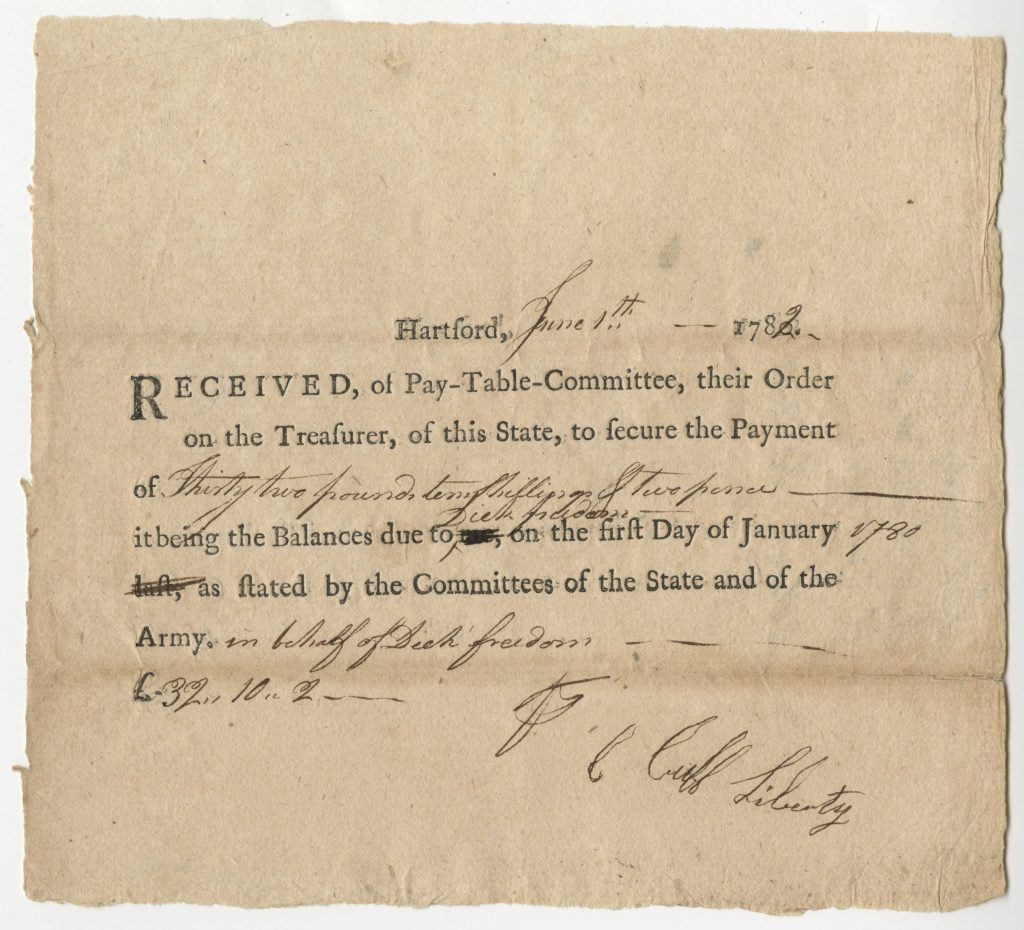
Partially printed D.S., Hartford, June 7th 1782: receipt of Pay-Table-Committee
1782The Society of the Cincinnati
Payment receipt signed for Dick Freedom by Cuff Liberty. Dick Freedom and Cuff Liberty were African American participants in the Revolutionary War who adopted aspirational names during their service. They served in the all-African American Second Company of the Fourth Connecticut Regiment.
In League with Liberty: The Persistence of Patriots of Color and the Formation of the First Rhode Island Regiment of the Continental Army
Robert Geake
February 16, 2023The American Revolution Institute of the Society of the Cincinnati
As states struggled to fill enlistment quotas in late 1777, the Rhode Island General Assembly, drawing from a proposal from Rhode Island general James Varnum, voted to allow the enlistments of indentured servants, indigenous peoples and former slaves. With that, the First Rhode Island Regiment, known as “the black regiment,” was formed. Although met with controversy, the regiment fought with distinction in various battles during the Revolutionary War. To mark the anniversary of an important vote on February 14, 1778, in the Rhode Island general assembly that allowed African Americans and Indigenous peoples to enlist for service, historian Robert A. Geake discusses the important story of the “black regiment,” from its formation, heroism and misfortune, to the legacy left by those who enlisted to earn their freedom.